This post may contain affiliate links. Please read our disclosure policy.
Learn how to make a classic vegan pie crust at home with just 3 ingredients! It’s buttery, flaky, and perfect for making sweet pies as well as savory tarts. Plus, I’m sharing two ways to make it!

⭐️ Why You Should Try This Recipe
- Versatile. I believe everyone should have a good pie crust recipe on hand! It can be used to make savory tarts like this Zucchini Tart or Mushroom Tart, but also for sweet tarts like fruit or Chocolate Tart!
- It tastes better and is healthier than store-bought. After trying this crust, you will never want to buy it at the store again. It has a rich buttery flavor and the perfect flakiness!
- Super easy to make. If you have flour, butter, salt, and 15 minutes, you can make this pie crust at home. It can be prepared in a bowl by hand or using a stand mixer to save time.
🧈 Ingredient Notes
Pie crust only requires pantry staples everyone has at home. Here is what you will need:
- Flour – The good old-fashioned all-purpose flour works great here.
- Butter – You can use store-bought vegan butter or homemade vegan butter.
- Salt – To enhance the flavor of the crust. Even if you are making a sweet crust, do not omit the salt.
- Cold water – You will need cold water to help the dough come together.
- Sugar – Optional. Only use it if you are making a sweet pie crust. You can use powdered sugar, granulated white sugar, or light brown sugar. I do not recommend using coconut sugar as it will darken the dough and will not get incorporated well.
Vegan butter vs. coconut oil
While you can use coconut oil to make pie crust, I had the best results while using vegan butter. It not only yields a superior texture but also a better flavor.

📙 Types of Crusts
Before starting, let’s take a look at two different types of French pastry.
- Shortcrust Pastry: Called “pâte brisée” in French, this version of the crust is best used to make savory tarts. It has a crunchy and slightly crumbly texture. While it’s usually unsweetened, it’s possible to add sugar if needed. The process of making this pastry consists of first creaming softened butter and then combining it with the flour.
- Sweet Crust Pastry: Called “pâte sablée” in French, this pastry has a more flaky and sandy texture and is sweetened. It’s best used in desserts like chocolate or fruit tarts. The process of making this pastry consists of sanding cold butter with the flour, allowing the butter to coat the flour, creating a sandy texture.
In the step-by-step below, I will show you how to make the latter one. Check out the recipe card to learn how to make both types of crusts.
🥧 How to Make Vegan Pie Crust
Prepare the dough
The process of making vegan pie crust requires just one bowl and can be done in less than 10 minutes (even less if you are using a stand mixer!). Here is how to make the dough:
- Mix the dry ingredients. Add the flour, salt, and sugar (if using) to a bowl.
- Add the butter and cut it in. Using a pastry cutter or the beater attachment of your mixer, sand the cold butter with the flour. If you don’t have any of those, simply use your hands, it works as well.
- Mix. Once the texture looks like a fine semolina/sand, add 1-2 tablespoons of cold water and mix the dough. If the dough appears too dry, add one more tablespoon of water at a time until it comes together. The dough should be soft but not sticky. If it’s sticky, add a bit more flour.
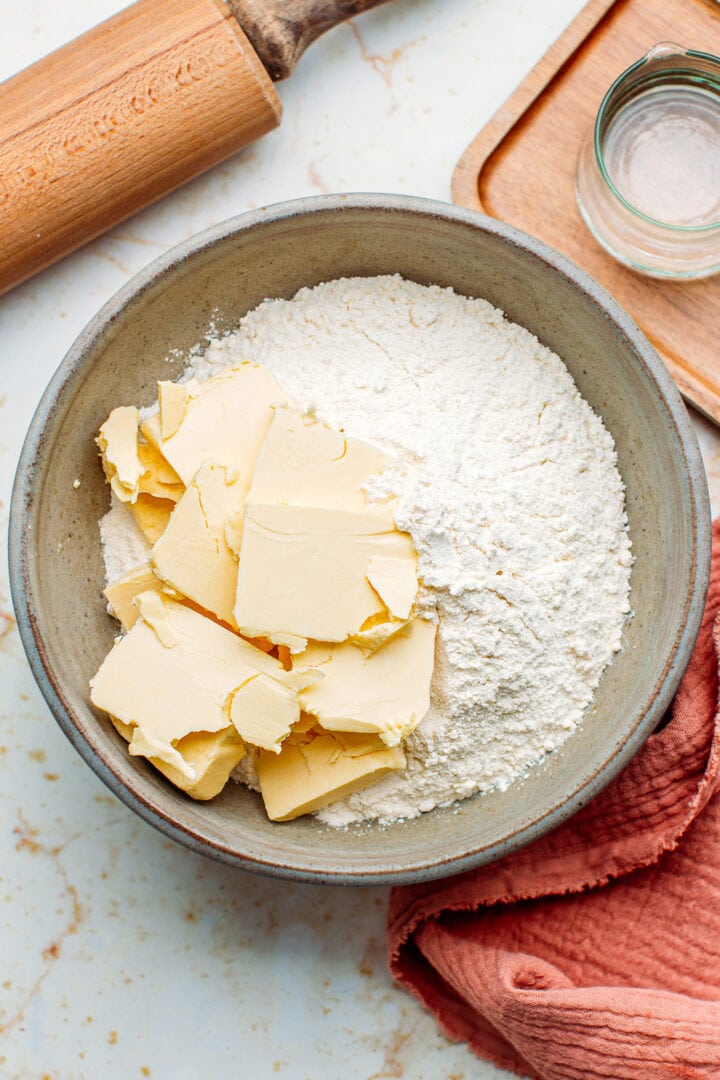

At this point, you can flatten the dough or shape it into a thick disc and keep it in the refrigerator for up to 4 days. Let it rest on the counter for about 10 minutes before rolling it out.
Roll out
To roll out the dough:
- Flour your working surface. Lightly flour your kitchen counter and rolling pin.
- Roll it out. Place the disc of dough on your surface and roll it out into a 1/4-inch thickness.
A quick tip: If you don’t want to create a mess by dusting your kitchen counter with flour, simply lay a sheet of parchment paper on it. Then place your disc of dough on top of it and cover it with another layer of parchment paper. You can then roll out your dough.

Next, transfer the dough to your pie plate and cut off the excess dough, leaving about a 1/2-inch overhang. Gently press the dough into the sides.
If there is still excess dough, trim it using a pair of scissors or run the rolling pin on the edges of the plate to cut it off.
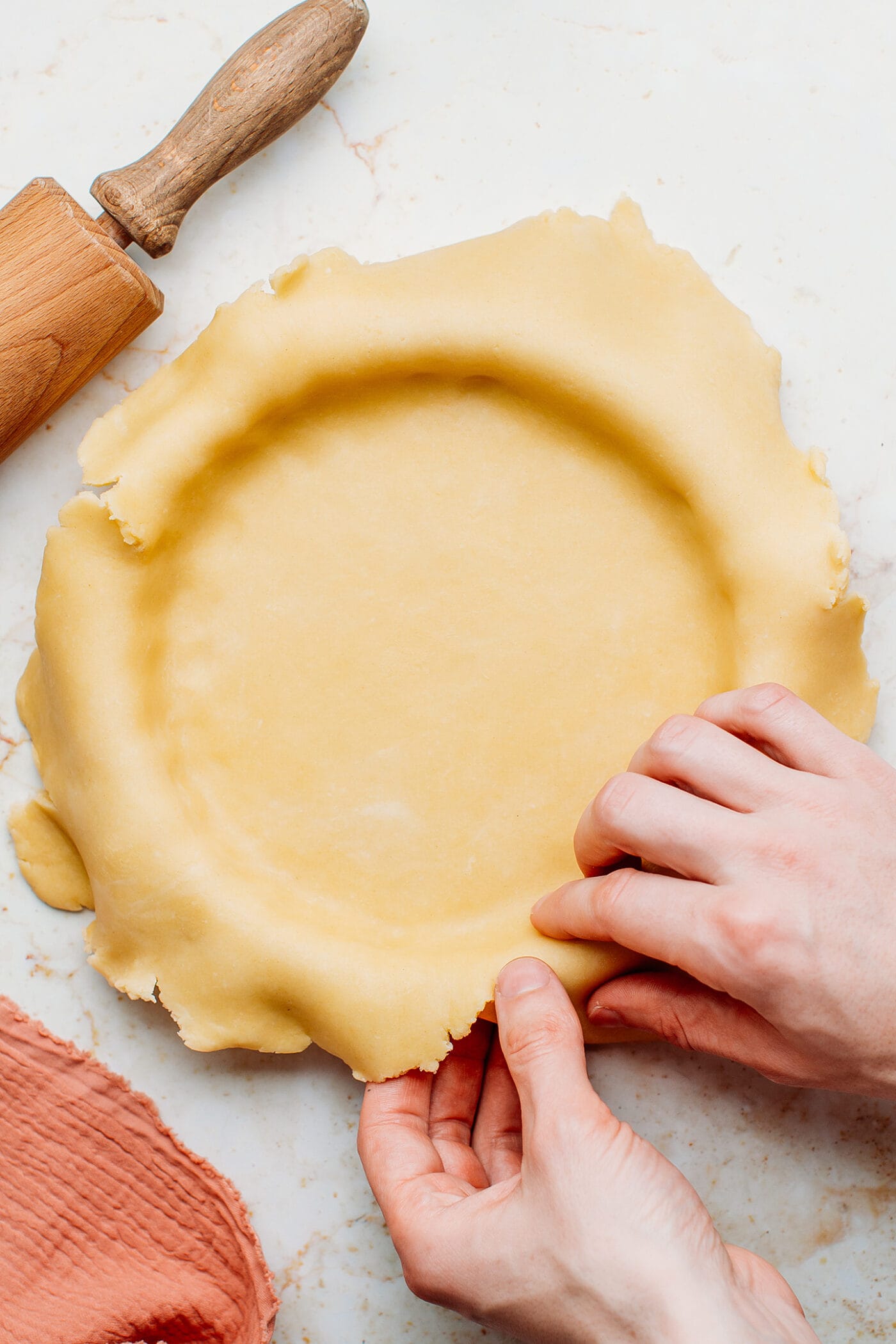
Bake
Finally, it’s time to bake! You have two options depending on what you are making: bake with the filling or blind bake:
- Preheat your oven to 355°F (180°C).
- Prick the bottom of the dough with a fork. This will allow the steam to escape and prevent the crust from puffing up.
- If you are baking with a filling: Add your filling and bake according to the recipe’s instructions.
- If you are blind baking: Cover the bottom of your pie crust with a round piece of parchment paper. Top with pie weights or dry beans. Bake for about 15 minutes or until the sides are slightly golden brown. Next, remove the weights and the parchment paper and bake for another 12-15 minutes.
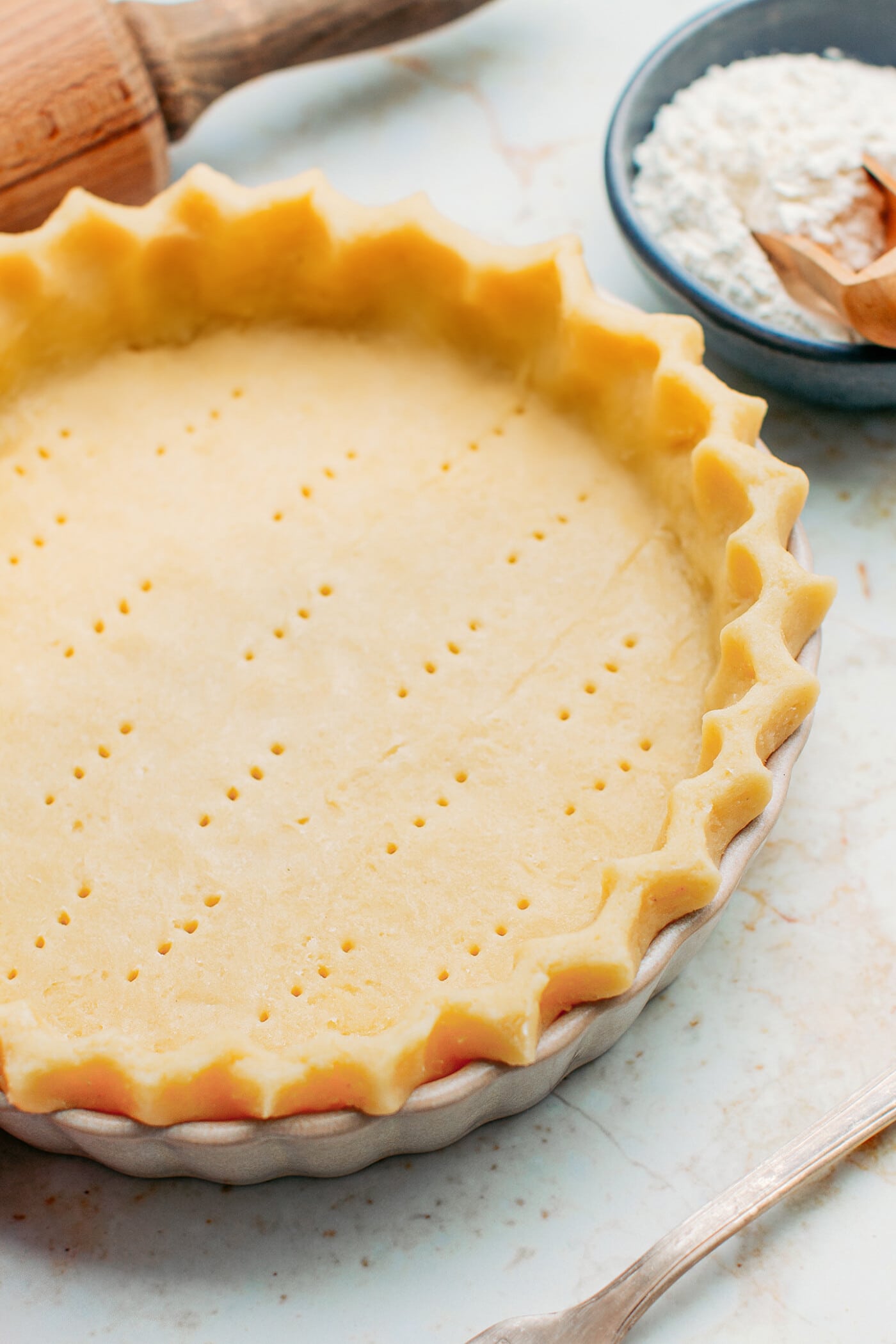
❄️ Freezing
You can easily double the recipe to make two pie crusts and freeze one for later use. To do so, flatten your dough and press it into a tart pan. Cover with plastic wrap and freeze for up to 3 months. Once ready to use it, let the crust thaw on the counter for 15-20 minutes, add your filling and bake!
Note: depending on your oven and type of filling, you might have to bake it for an extra 10 minutes.
📔 Tips
- Do not overmix. Especially if you are making sweet crust pastry. Stop mixing as soon as the dough comes together. Otherwise, it will result in a chewy texture.
- Adjust the amount of water. Depending on the brand of flour used, you might have to use more or less water. Start with 2 tablespoons and add more as needed.
- Use a stand mixer. If you want to save time, you can prepare the dough in a stand mixer fitter with a flat beater attachment. It works perfectly and keeps your hands clean!
- Adjust the thickness. Depending on your preference and the type of tart/pie you plan to make, feel free to roll out the dough thinner. I personally like more rustic tarts with a thick crust, but that is totally up to you.
- Flavor the dough. Feel free to add fresh or dried herbs if preparing a savory tart, or cinnamon, lemon zest, cinnamon, or vanilla for a sweet pie!
💬 FAQ
Yes, you can re-roll the dough once. Re-rolling a second time will alter the texture of the crust.
One batch of dough will yield about two 8-inch pies or one large 11-inch pie.
Your oven temperature might be too hot. Next time, try lowering the temperature and place the crust lower in your oven. You can also use a pie crust shield to prevent the edges from browning too quickly.
You can keep the dough wrapped in plastic film for up to 4 days in the refrigerator.
🌿 More Basic Vegan Recipes
Let me know in the comments if you try this recipe!
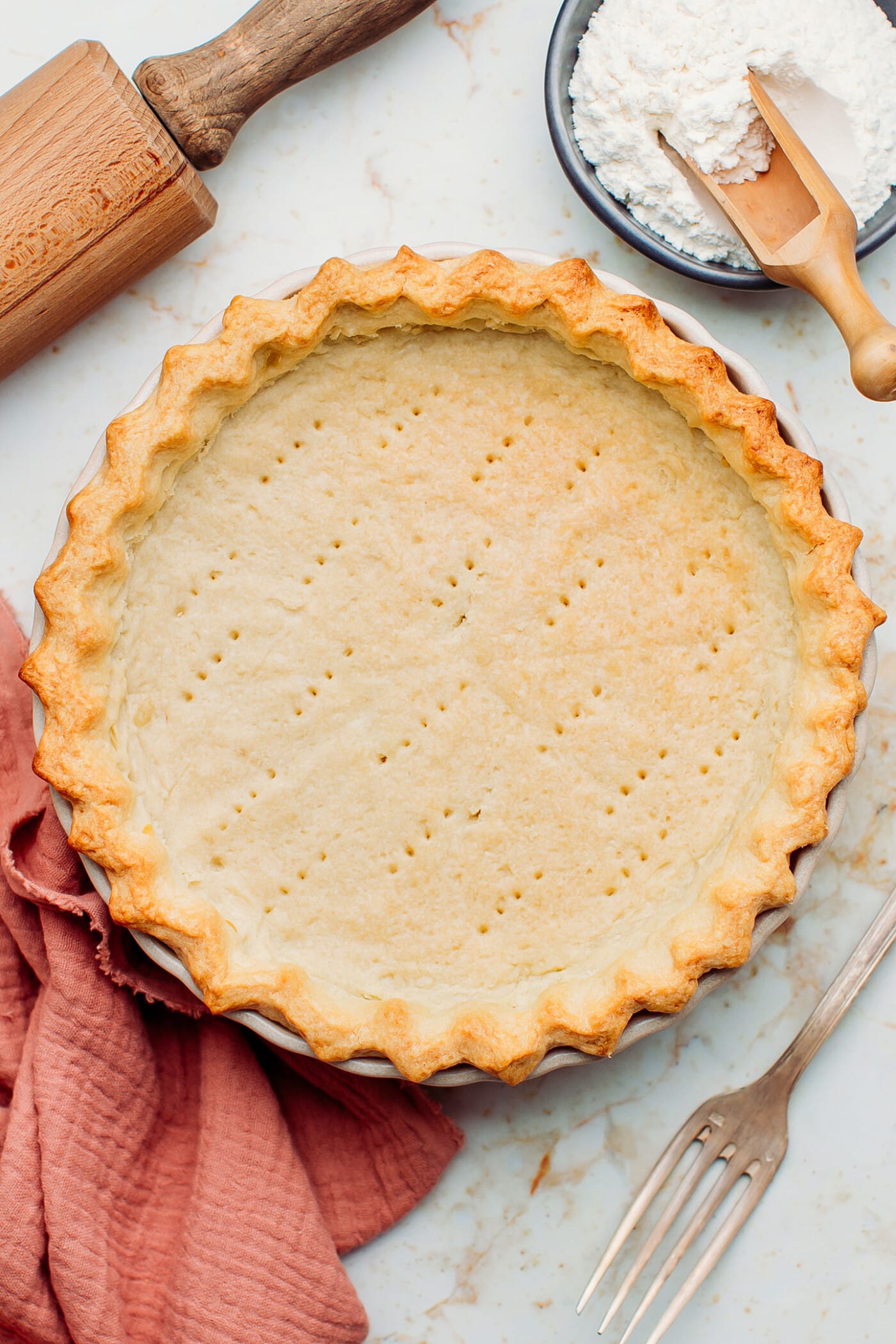

Vegan Pie Crust (2 Ways!)
Ingredients
Shortcrust Pastry Version
- 120 g vegan butter at room temperature
- 250 g all-purpose flour
- 1/4 tsp salt
- 2-3 tbsp water add more if needed
Sweet Crust Pastry
- 250 g all-purpose flour
- 1/4 cup powdered sugar
- 1/4 tsp salt
- 140 g cold vegan butter diced
- 1-2 tbsp ice cold water add more if needed
Instructions
- Before starting: be aware that this recipe will yield either one 11-inch pie crust or two 8-inch pie crusts.
Shortcrust Pastry Version
- Called "pâte brisée" in French, this version of the crust is best used to make savory tarts. It has a crunchy and slightly crumbly texture.
- Add the softened vegan butter to a bowl and cream it for about 1 minute using a spatula or the beater attachment of a stand mixer.
- Next, add the flour, and salt, and knead for about 2 minutes or until it looks like a coarse meal.
- Pour in 2 tablespoons of water and knead again. If the dough appears too dry, add more water, one tablespoon at a time, until it forms a firm but not crumbly dough. Shape into a ball and flatten into a thick disc.
- You can then flatten the dough on a floured surface and use it to make tarts or pies!
Sweet Crust Pastry Version
- Called "pâte sablée" in French, this pastry has a more flaky and sandy texture and is sweetened. It's best used in desserts like chocolate or fruit tarts.
- In a mixing bowl, whisk together the flour, powdered sugar, and salt.
- Add the diced cold butter and cut it into the dry ingredients using a pastry cutter or the beater attachment of a stand mixer. Alternatively, you can also use your hands.
- Once the texture looks like fine semolina, add 1-2 tablespoons of cold water and mix the dough. If the dough appears too dry, add one more tablespoon of water at a time until it comes together. The dough should be soft but not sticky. If it's sticky, add a bit more flour.
- Shape into a ball and flatten into a thick disc. You can then flatten the dough on a floured surface and use it to make sweet pies!
To Blind Bake
- Preheat your oven to 355°F (180°C).
- Roll out the dough: Place the disc of dough on a working surface and roll it out into a ¼-inch thickness.
- Next, transfer the dough to your pie plate and cut off the excess dough, leaving about a ½-inch overhang. Gently press the dough into the sides.If there is still excess dough, trim it using a pair of scissors or run the rolling pin on the edges of the plate to cut it off.
- Prick the bottom of the dough with a fork. This will allow the steam to escape and prevent the crust from puffing up.
- Cover the bottom of your pie crust with a round piece of parchment paper and top with pie weights or dry beans.
- Bake for about 15 minutes or until the sides are slightly golden brown. Next, remove the weights and the parchment paper and bake for another 12-15 minutes.
- You can then fill the pie crust with chocolate ganache, pastry cream, fresh, fruits, etc!
Notes
- Do not overmix. Especially if you are making sweet crust pastry. Stop mixing as soon as the dough comes together. Otherwise, it will result in a chewy texture.
- Adjust the amount of water. Depending on the brand of flour used, you might have to use more or less water. Start with 2 tablespoons and add more as needed.
- Use a stand mixer. If you want to save time, you can prepare the dough in a stand mixer fitter with a flat beater attachment. It works perfectly and keeps your hands clean!
- Adjust the thickness. Depending on your preference and the type of tart/pie you plan to make, feel free to roll out the dough thinner. I personally like more rustic tarts with a thick crust, but that is totally up to you.
- Flavor the dough. Feel free to add fresh or dried herbs if preparing a savory tart, or cinnamon, lemon zest, cinnamon, or vanilla for a sweet pie!
Nutrition

About the Author
Thomas Pagot is the founder, photographer, and recipe developer behind Full of Plants. He created the blog in 2016 as a personal cookbook for vegan recipes. Through years of recipe development, Thomas has successfully grown Full of Plants into a trusted resource for plant-based recipes.
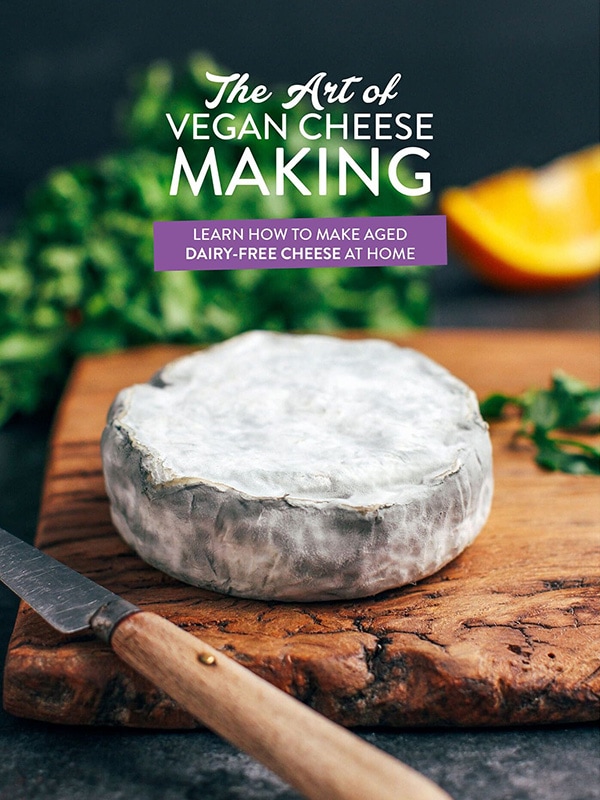
🧀 25 Mind-Blowing Vegan Cheese Recipes!
Sign up for the Full of Plants newsletter and you’ll get new recipes delivered by email weekly, PLUS your FREE 100-page printable eBook!

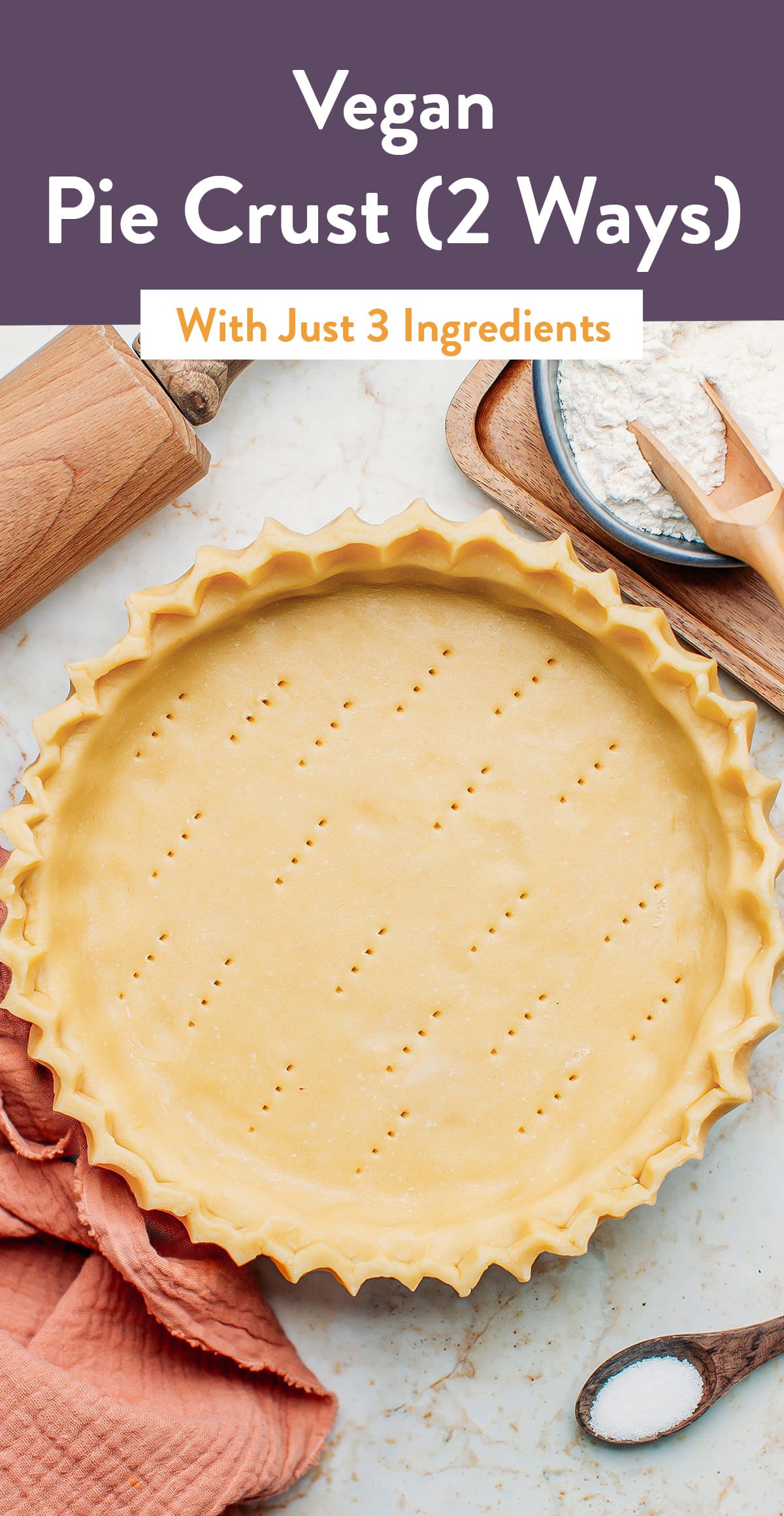
Bonjour Thomas, depuis que vous avez affiché la recette de tarte aux champignons, j’espérais obtenir votre recette de pâte à tarte. Merci!
Puis-je vous demander quels sont vos antécédents? Chimie alimentaire? Vos recettes sont fantastiques et vraiment différentes de ce que l’on trouve sur d’autres sites. Merci de partager votre passion.
Bonjour Danielle,
De rien et merci beaucoup! Je n’ai pas “d’antécédents”, juste beaucoup de pratique 😉
Look amazing. I’ll try it this weekend. Thanks!
Looks great. I’d love to know how you flute your crust so well! Mine always start out fine but by the end the crust begins to look like a mash up. Quite rustic I will admit but not the refined look I’m going for.